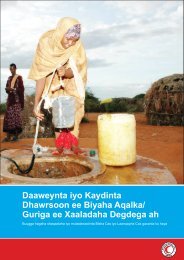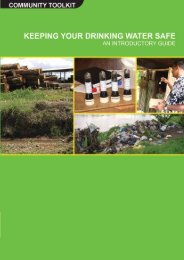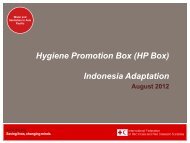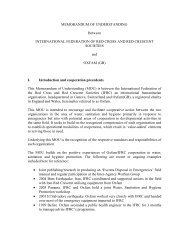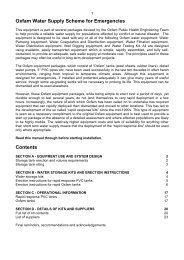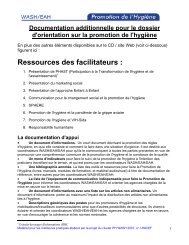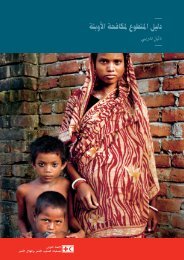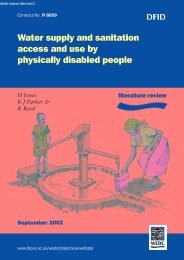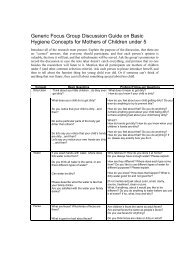Hygiene Promotion - IRC International Water and Sanitation Centre
Hygiene Promotion - IRC International Water and Sanitation Centre
Hygiene Promotion - IRC International Water and Sanitation Centre
You also want an ePaper? Increase the reach of your titles
YUMPU automatically turns print PDFs into web optimized ePapers that Google loves.
5. Case studiesOn the following pages case studies are arranged by Regions (Africa, Asia, Latin America)<strong>and</strong> within those regions by country. They have also been keyworded according to thetopics covered. Check the topic list below for links to the study on your topics of interest.Advocacy Zimbabwe 3Baseline study Palestine 1Demonstration projects Zimbabwe 2, 3H<strong>and</strong>washing promotion Guatemala 1Health Clubs Zimbabwe 1,2<strong>Hygiene</strong> game Ghana 1<strong>Hygiene</strong> Improvement framework (HIF) Palestine 1; Nicaragua 1Impact of hygiene promotion Niger 1; Zimbabwe 1; Zimbabwe 2Palestine 1Indicators Zimbabwe 2Institutional support Zimbabwe 2, 3Integrated projects Ghana 1; Zimbabwe 3; India 1KABP study Ghana 1; Zimbabwe 1, 2Locally developed approaches Ghana 1, Zimbabwe 1,2Messages <strong>and</strong> media Ghana 1;Zimbabwe 1; Guatemala 1PHAST India 1; Zimbabwe 2Social marketing Guatemala 1; Nicaragua 1Training of hygiene promoters Ghana 1; India 1; Nicaragua 1, Zimbabwe 25.1 Case studies: AfricaGhana 1: Integrating health <strong>and</strong> hygiene into a water <strong>and</strong> sanitation projectTopics: Integrated projects; KABP study; locally developed approaches; hygiene game;messages <strong>and</strong> media; training of hygiene promoters.This is a field example from the Northern <strong>Water</strong> <strong>and</strong> <strong>Sanitation</strong> Project (NORWASP) inNorthern Ghana. Central to this project is the integration of health <strong>and</strong> hygiene into watersupply <strong>and</strong> sanitation for rural communities. The majority of these communities have noexisting protected water supplies <strong>and</strong> all are without adequate means of sanitation. ‘Freerange’, or open defecation is the sanitation practice throughout. The project conducted aKABP baseline, which entailed a number of tools - many participatory, drawing from thePLA approach combined with observation <strong>and</strong> a brief questionnaire. A gender lens wasincorporated throughout, although (in retrospect) more specific inclusion of children couldhave been made. Information from this baseline was used to:• identify key risk <strong>and</strong> safe practices,• identify challenges / barriers to engaging in safe practices,• identify the interest in <strong>and</strong> willingness to pay for facilities,<strong>IRC</strong> <strong>International</strong> <strong>Water</strong> <strong>and</strong> <strong>Sanitation</strong> <strong>Centre</strong> 33



